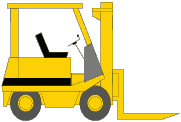Effects of Overdischarging Motive Power Batteries.
WASEEM AHMAD, Vice President-Engineering, KW POWERSOURCE, Inc., Ooltewah, TN
May, 1997 Plant Engineering
In normal discharging of a battery, lead dioxide of the positive plates, and spongy lead of the
negative plates, are both converted to lead sulfate. The ideal discharge mode for motive power batteries is to
discharge to 80% of full-charge capacity, at which point battery voltage is 1.8 volts/cell.
At the recommended minimum discharge point, discharged plates still have retained a significant
amount of active material - lead dioxide on the positive plates, and spongy lead on the negative plates. If discharging
is continued beyond this point, an excessive amount of lead sulfate forms - and it is very difficult to convert
excessive sulfate to active material via conventional charging practices.
The table "Example Voltage Patterns Resulting from Overdischarge" provides a 6-cell
example of voltage readings that might occur on a battery poised for rapid decline in capacity and life expectancy
because of overdischarging; all voltages shown are open-circuit volts. By the 6th hour of discharge, two cells
have actually reversed in polarity. The battery overheats, and this heat, in turn, damages the battery electrochemical
balance. Soon other cells also reverse in polarity, and the battery is unable to deliver even a minor portion of
its rated capacity.
- Overdischarge/Undercharge.
In real-life plant situations, there is often not enough time to restore an overdischarged battery
to the fully charged state. Consider the typical three-shift operation in which two batteries are provided per
lift truck, with one shift allotted for charging the battery discharged on the previous shift.
If the battery has been overdischarged to the point that there is not enough time in the next
shift to fully recharge the battery, it becomes undercharged battery that has been pressed into service. Every
time this occurs, more excessive lead sulfate is created, and less active material is available for electrochemical
reaction. The battery progressively deteriorates, because it is always being undercharged.
A proper battery maintenance program detects whether overdischarging/undercharging is occurring
by taking specific gravity readings at the end of each discharge cycle and each charge cycle.
- Effects of Overdischarging.
In the long term, chronic overdischarging has three detrimental effects:
- formation of hard sulfation (crystallized sulfate)
- loosening of battery plate active material
- plate buckling.
Hard sulfation. While repeated overdischarging causes the formation of excessive sulfate, the
long-term effect is to cause hard sulfation. Hard sulfate cannot be converted to lead dioxide in the charge cycle.
Hard sulfation eventually sheds, leaving less active material available for the electrochemical action.
Loosening of active material. As more and more lead sulfate accumulates and cannot be converted
to active material in the course of normal charging procedures, paste of the active materials expands abnormally.
Eventually, this expansion loosens portions of the active material from plates, reducing the
amount of active material.
Plate buckling. Extreme overdischarging leads to physical deformation of the grids that contain
the active material; this process is called "buckling." Buckling causes active material to break away
from the grid.
Alleviating the Effects.
Deterioration caused by undercharging is alleviated by applying an equalizing charge on a regular
basis. With an equalizing charge - typically applied over a weekend - a lower charge rate is applied, but for a
longer time. An equalizing charge minimizes minor discrepancies between cells. A weekly equalizing charge is recommended
even if the battery has not been subjected to undercharging.
In severe cases of overdischarge/undercharge abuse, the cell lead sulfate crystallizes (hard
sulfation) - and once crystallized, the material can no longer be converted to lead dioxide and spongy lead. This
problem is exacerbated by "80%"-type battery chargers. With such chargers, the finish charge rate is
based on a presumed 80% discharge, rather than the actual discharge level.
Thwarting Overdischarging.
Various devices generically known as "lift interrupts" are available to thwart overdischarging.
Such devices disable the truck lift mechanism when the 80% discharge point is reached, forcing the operator to
return to the charging station.
Interrupts also prevent battery abuse by overzealous operators working on a piecework incentive
basis.
Application of lift interrupts presumes that a spare battery is available that can be pressed
into service when needed. It is also axiomatic that the interrupt's tamper-proof features should be evaluated before
committing to purchase of a particular device.
Lift interrupts operate as a function of battery electrolyte specific gravity, and problems can
occur if an interrupt is not properly adjusted. Users of such devices sometimes adjust the interrupt to the recommendation
of the lift truck manufacturer. Lift truck manufacturers' recommendations, however, are intended to be only rough
starting-point guidelines as preludes to refined final adjustments, and are often based on battery open-circuit
voltages.
Proper adjustment of the interrupt must be based on the specific gravity at 80% discharge for
the particular battery type, as given by the battery manufacturer. It is also recommended that interrupt points
be checked on a regular basis, with an annual check recommended as a minimum.
 FORKLIFT OPERATION AND SERVICE.
FORKLIFT OPERATION AND SERVICE.
BE SURE TO VISIT THE HOME PAGE FOR INFORMATION ON LIFT TRUCKS REPAIR, SERVICE, TROUBLESHOOTING,
AND EVERYTHING YOU NEED TO KNOW ABOUT FORKLIFTS AND THEIR USE.


